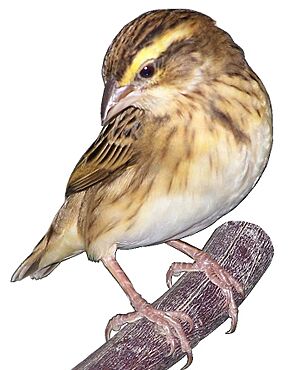Yellow-crowned bishop facts for kids
Quick facts for kids Yellow-crowned bishop |
|
|---|---|
 |
|
 |
|
| A breeding male (E. afer subsp. taha) displaying near Lake Baringo, Kenya, and a captive female (nominate race) | |
| Conservation status | |
| Scientific classification | |
| Genus: |
Euplectes
|
| Species: |
afer
|
| Synonyms | |
|
Taha afer |
|
The yellow-crowned bishop (Euplectes afer) is a small passerine bird that lives in Africa. It belongs to the Ploceidae family, which includes weavers and bishops. These birds are found south of the Sahara desert.
During the breeding season, the male yellow-crowned bishop looks very different from the female. The male gets bright yellow and black feathers. The female, however, stays mostly brown. There are four different types, or subspecies, of this bird.
Contents
About the Yellow-Crowned Bishop
The yellow-crowned bishop was first officially described in 1789. A German scientist named Johann Friedrich Gmelin gave it its scientific name. The name afer comes from Latin and means "Africa."
This bird is also known by other names. Some people call it the golden bishop or Napoleon bishop. In Dutch, it's called Napoleonwever. In German, it's Napoleonweber.
Different Types of Yellow-Crowned Bishops
Scientists recognize four main types, or subspecies, of the yellow-crowned bishop:
- E. a. strictus is found in central Ethiopia.
- E. a. afer lives from Mauritania and Senegal to West Sudan and northwest Angola.
- E. a. ladoensis is found from South Sudan to North Tanzania.
- E. a. taha lives in southwest Angola, Zambia, and South Africa.
What Does the Yellow-Crowned Bishop Look Like?
The yellow-crowned bishop is a small bird. It is about 9.5 to 10.5 centimeters (3.7 to 4.1 inches) long. It weighs around 15 grams (0.5 ounces).
Male and Female Differences
During the breeding season, the male bird changes a lot. Its feathers become a bright golden yellow and black. Its beak turns black. The male has a black face, throat, chest, and belly. It also has a wide black collar on its neck. Its crown, forehead, and back of the head are a brilliant yellow. There is also a yellow patch on its shoulder. The lower back is yellow, and its wings and tail are brown.
When it's not breeding season, the male's feathers look like the female's. Its beak also changes to a horn color. The female yellow-crowned bishop is mostly pale brown. She has darker streaks on her upper body. Her eyebrows are lighter. Her belly is off-white with thin dark streaks on her chest. Both sexes have pinkish-brown legs and feet. Their beaks are short and cone-shaped.
How to Tell Them Apart from Other Birds
A breeding male yellow-crowned bishop looks a bit like the yellow bishop. However, the yellow bishop is a larger bird. It also does not have a yellow crown on its head.
Non-breeding males and females can be confused with the southern red bishop. But yellow-crowned bishops have white underparts. Southern red bishops have buff-colored (light yellowish-brown) underparts.
Where Do Yellow-Crowned Bishops Live?
The yellow-crowned bishop is native to many African countries. These include Angola, Botswana, Ethiopia, Kenya, South Africa, and Sudan. It has also been brought to other countries. These places include Jamaica, Japan, Puerto Rico, Portugal, and Spain.
Favorite Places to Live
These birds like open areas. They prefer grasslands, wet areas called vleis, and dry lake beds. They also enjoy fields of wheat and sorghum. You can often find them in weedy areas near wetlands.
Yellow-Crowned Bishop Behavior and Life Cycle
Yellow-crowned bishops eat insects, grains, and seeds. They often live in groups with both males and females. When it's not breeding season, their groups might mix with other birds. These can include weavers and sparrows.
Sounds They Make
Their call is a high-pitched, buzzing sound. It sounds a bit like an insect. People describe it as "zzzzzzz, zzit, zzit, zzzz."
Nesting and Reproduction
Nesting usually happens from November to May. The busiest time is from December to March. Male yellow-crowned bishops are polygynous. This means one male will mate with several females. However, they do not nest together in large groups.
Each male builds two or more oval-shaped nests. These nests have an opening at the top. The male attracts a female to each nest. He does this by showing off his bright yellow feathers. He also performs special display flights.
Yellow-crowned bishops are social birds. They also move around a lot. They travel to breeding areas when it rains. They build their nests among tall grasses or sedges. Sometimes they build them in shrubs. Bent grass stems help to hide the nest.
The female bird lays two to four white eggs. Only the female sits on the eggs to keep them warm. This takes about 12 to 14 days. The baby chicks leave the nest after 11 to 13 days. They are fully independent about five weeks later.
Gallery
-
E. a. afer breeding male (J.F.Gmelin, 1789) in Irvine, California, where exotic
-
E. a. strictus breeding male, G.Hartlaub, 1857, in the Ethiopian Highlands





